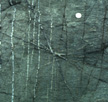Favorite Structures, Worldwide!

Devonian Crinoid Columnal, Appalachian Plateau
Wellsville, NY, U.S.A.

This photograph is a thin section cut through the axial canal of a crinoid columnal.
The opening in the axial canal is pentagonal in shape indicating that the crinoid is
a distant cousin of the starfish. Individual columnals of the crinoid are single
crystals of calcite with their c-axis oriented parallel to the axial canal. In this
orientation the calcite crystal is extinct (i.e., dark) under crossed nicols. Three sets
of calcite twins are visible near the axial canal. The distribution of these twins
indicates that remote or tectonic stress was concentrated by the hole constituting
the axial canal. Another geological example of such an elastic stress concentration is
found at the edge of a well bore where a magnified stress causes the well to spall away
forming a borehole breakout.
Reference:
Engelder, T., 1982, A natural example of simultaneous operation of free-face dissolution and pressure solution: Geochemica et Cosmochimica Acta, v. 46, p. 69-74.

Veins in Ordovician Clastic Rocks,
Bermagui, Australia

When propagating, joints and their filled counterparts, veins, are very sensitive to the orientation of the least principal stress. In-plane propagation is always normal to the maximum effective tensile stress. The veins in this photo demonstrate the complex stress history to which these Ordovician clastic rocks have been subjected. A careful look will reveal that there are six (6) major vein sets. Cross cutting relationships indicate that the least stress rotated clockwise through 120 degrees, leaving a trail of veins behind. Depending of the choice of coordinate system, the geologist could say that either the rock was spinning wildly in a fixed stress system or the stress system was spinning about this clastic section. Probably the rock suffered a little of both.
Reference:
Williams, P.F., 1972, Development of metamorphic layering and cleavage in low grade metamorphic rocks at Bermagui, Australia, American Journal of Science, v. 272, p. 1-47.

Clastic Dike in Ordovician Clastic Rocks,
Delaware Water Gap, NJ-PA, U.S.A.

Earlier in the 20th Century the mechanism associated with cleavage formation was not well understood. One early interpretation was based on this outcrop of the Ordovician Martinsburg Formation near the Delaware Water Gap, NJ-PA. The Martinsburg consists of alternating sandstone and shale layers with the shale well cleaved. Here clastic dikes are found subparallel to a slaty cleavage that is dipping down and to the right. An early interpretation was that slaty cleavage formed during early dewatering of marine sand-shale sequences. Water caused the physical rotation of the small mica flakes to form a penetrative cleavage much like the March Model would predict. Because of the fame of this outcrop during the through the 1970s, someone took a geology pick and removed this well-known structure. Sadly it now exists only in hyperspace.
Reference:
Maxwell, J.C. 1962, Origin of slaty and fracture cleavage in the Delaware Water Gap area, New Jersey and Pennsylvania, in Engel, A.E.J., James H.L., and Leonard, B.F., eds., Petrologic studies: A volume in honor of A.F. Buddington: Boulder, Colorado, Geological Society of America, p. 291-311.



To be completed
Back to Geosciences homepage
Back to Penn State homepage










